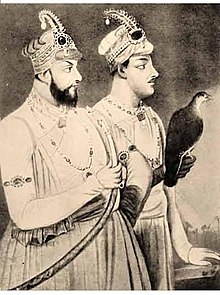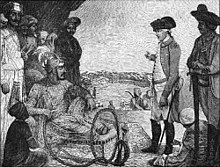29 JUN 1757-60 NAWAB MIR JAFAR ENTHRONED BENGAL,BIHAR_ORISSA
Mir Jafar
From Wikipedia, the free encyclopedia
For the village in Iran, see Mir Jafar, Iran.
| Mir Jafar | |||||
|---|---|---|---|---|---|
| Nawab of Bengal, Bihar and Orissa (Nawab of Bengal)Shuja ul-Mulk (Hero of the country)Hashim ud-Daulah (Sword of the state)Ja'afar 'Ali Khan Bahadur Mahabat Jang (Horror in War) | |||||

Mir Jafar (left) and his eldest son, Mir Miran (right).
| |||||
| Reign | 1757–1760 and 1763-1765 | ||||
| Predecessor | Siraj ud-Daulah | ||||
| Successor | Mir Qasim (after 1760) andNajimuddin Ali Khan (after 1765) | ||||
| Born | 1691 | ||||
| Died | January 17, 1765 (aged 74) | ||||
| Burial | Jafarganj Cemetery,Murshidabad | ||||
| Wives |
| ||||
| Issue |
Sadiq Ali Khan Bahadur (Mir Miran)
Husaini Begum and 2 more daughters.Najimuddin Ali Khan Bahadur Najabut Ali Khan Bahadur (Mir Phulwari) Ashraf Ali Khan Bahadur Mubaraq Ali Khan Bahadur Hadi Ali Khan Bahadur Fatima Begum Sahiba Misri Begum Roshan-un-nisa Begum Sahiba (Nishani Begum) | ||||
| |||||
| Dynasty | Najafi | ||||
| Father | Sayyid Ahmed Najafi (Mirza Mirak) | ||||
| Religion | Islam | ||||
Mir Jafar Ali Khan Bahadur (c. 1691–February 5, 1765) was the first Nawab of Bengal with support from British East India Company. He was the second son of Sayyid Ahmad Najafi. His rule is widely considered the start ofBritish imperialism in India and was a key step in the eventual British domination of vast areas of the subcontinent. Siraj ud-Daulah, the previous Nawab of Bengal along with his army were defeated and killed in the Battle of Plassey by the British due to the betrayal of the commander of Siraj ud-Daulah′s army, Mir Jafar, who betrayed Siraj ud-Daulah to become the next Nawab. Thus after helping the British defeat Siraj ud-Daulah he became the new Nawab of Bengal in 1757 with military support from the British East India Company as a reward for his betrayal. However, Jafar failed to satisfy constant British demands for money. In 1758, Robert Clive discovered that through his agent Khoja Wajid, Jafar had made a treaty with the Dutch at Chinsurah. Dutch ships of war were also seen in the River Hooghly. Circumstances led to the Battle of Chinsurah. British company official Henry Vansittart proposed that since Jafar was unable to cope with the difficulties, Mir Qasim, Jafar's son-in-law, should act as Deputy Subahdar. In October 1760, the company forced him to abdicate in favor of Qasim. However, Qasim's independent spirit and plan to force the East India company out of his dominion led to his overthrow, and Jafar was restored as the Nawab in 1763 with the support of the company. Mir Qasim however refused to accept this and went to war against the company. Jafar ruled until his death on January 17, 1765 and lies buried at the Jafarganj Cemetery in Murshidabad, West Bengal, India.
Contents
[hide]Subedar of the Nawab of Bengal[edit]
In 1747 the Marathas led by Raghoji I Bhonsle, began to raid, pillage and annex the territories of the Alivardi Khan, the Nawab of Bengal. During the Maratha invasion of Odisha, its subedar Mir Jafar and Ataullah the faujdar ofRajmahal completely withdrew all forces until the arrival of Alivardi Khan and the Mughal Army at the Battle of Burdwan where Raghoji I Bhonsle and his Maratha forces were completely routed. The enraged Alivardi Khan then dismissed the shamed Mir Jafar.[1]
Nawab of Bengal[edit]
Mir Jafar pretended loyalty to Alivardi Khan's successor Siraj Ud Daulah, but betrayed him to the British in the battle of Palashi.[2] After Siraj Ud Daulah’s defeat and subsequent execution, Jafar achieved his long-pursued dream of gaining the throne, and was propped up by the British East India company as puppet Nawab. Jafar paid Rs. 17,700,000 as compensation for the attack on Calcutta to the company and traders of the city. In addition, he gave bribes to the officials of the company. Clive, for example received over two million rupees, Watts over one million[3] Soon, however, he realized that company's expectations were boundless and tried to wriggle out from under them; this time with the help of the Dutch. However, the British defeated the Dutch at the Battle of Chinsurah in November 1759 and retaliated by forcing him to abdicate in favor of his son-in-law Mir Qasim. However, Qasim proved to be both able and independent, strongly condemned the interference of East India company in the governing of his domain. Mir Qasim formed an alliance to force East India company out of East India. The Company soon went to war with him and his allies. The Battle of Buxar was fought on 22 October 1764 between the forces under the command of the British East India Company led by Hector Munro and the combined army of Mir Qasim, the Nawab of Bengal: the Nawab of Awadh and the Mughal Emperor Shah Alam II. With the defeat in Buxar, Mir Qasim was eventually overthrown. Mir Jafar managed to regain the good graces of the British; he was again installed Nawab in 1763 and held the position until his death in 1765.
Shah Alam II's attempts to overthrow Mir Jafar[edit]
Main article: Treaty of Allahabad
"Some ill-designing people had turned his brain, and carried him to the eastern part of the Mughal Empire, which would be the cause of much trouble and ruin to our regimes."
In the year 1760 after gaining control over Bihar, Odisha and some parts of the Bengal, the Mughal Crown Prince Ali Gauhar and his Mughal Army of 30,000 intended to overthrow Mir Jafar, Imad-ul-Mulk after they tried to capture or kill him by advancing towards Awadh and Patna in 1759. But the conflict soon involved the assertive British East India Company. The Mughals were led by Prince Ali Gauhar, who was accompanied by Muhammad Quli Khan, Hidayat Ali, Mir Afzal and Ghulam Husain Tabatabai. Their forces were reinforced by the forces of Shuja-ud-Daula and Najib-ud-Daula. The Mughals were also joined by Jean Law and 200 Frenchmen and waged a campaign against the British during the Seven Years' War.[5]
Although the French were eventually defeated, the conflict between the British East India Company and the Mughal Empire would continue to linger and ended in a draw, which eventually culminated during the Battle of Buxar.
Legacy[edit]
The breakup of the centralized Mughal empire by 1750, led to creation of a large number of independent kingdoms (all provinces of the former Mughal empire). Each of them were in conflict with their neighbor. These kingdoms brought weapons from British-French East India company's to fuel their wars. Bengal was one such kingdom. British and French supported the princes whoever ensured their trading interest. Jafar was one such puppet who came to power with support of British East India company. After the defeat of Sirajuddoula and later Mir Qasim the British strengthened their position in Bengal and in 1793 abolished Nizamat (Mughal suzerainty) and took complete control of the former Mughal province. Jafar is widely reviled by the people of Bangladesh, India and Pakistan.[citation needed] The word "mirjafar" in Bengali and the phrase "meer jafar" in Urdu, are used much as quisling is used in English, and Jaichand of Kannauj in Indian history. Allama Iqbal, in his poetry wrote about his treachery in these words, "Jaffar az Bengal, Sadiq az Deccan; nang-e-deen, nang-e-millat, nang-e-watan" which mean "Jafar(Mir) of Bengal and Sadiq(Mir) of Deccan are a disgrace to the faith, a disgrace to Nation, a disgrace to Country. British with the help of Jafar and Mir Sadiq were able to take control of Bengal and kingdom of Mysore (Sultanat-e-Khuda daad)."
Jafar's great-grandson Iskandar Mirza, who had joined Army in 1920 in Military Police, was appointed and served as the first President of Pakistan.[6][7]
See also[edit]
Notes[edit]
- ^ "Riyazu-s-salatin", Ghulam Husain Salim - a reference to the appointment of Mohanlal can be found here
- ^ "Seir Muaqherin", Ghulam Husain Tabatabai - a reference to the conspiracy can be found here
- A website dedicated to Mir Jafar
Search Results
The Company Becomes The Diwan - YouTube
https://www.youtube.com/watch?v=TleewnoVTQU
Dec 31, 2015 - Uploaded by myEdu Learn
The Company Becomes The Diwan Nawabs of Bengal (full title, the Nawab Nizam of Bengal, Bihar and ...
Stay up to date on results for mir zafar installed as nawab of bengal orissa bihar.
Including results for mir jafar installed as nawab of bengal orissa bihar
Search only for mir zafar installed as nawab of bengal orissa bihar
Search only for mir zafar installed as nawab of bengal orissa bihar
Search Results
Mir Jafar - Wikipedia, the free encyclopedia
https://en.wikipedia.org/wiki/Mir_Jafar
Mir Jafar Ali Khan Bahadur (c. 1691–February 5, 1765) was the first Nawab of Bengal with ... During the Maratha invasion of Odisha, its subedar Mir Jafar and Ataullah the faujdar of Rajmahal completely ... In the year 1760 after gaining control over Bihar, Odisha and some parts of the Bengal, the Mughal Crown Prince Ali ...Nawabs of Bengal and Murshidabad - Wikipedia, the free encyclopedia
https://en.wikipedia.org/wiki/Nawabs_of_Bengal_and_Murshidabad
The Nawabs of Bengal were the rulers of the then provinces of Bengal, Bihar and Orissa. ... Nawab of Bengal was betrayed in the Battle of Plassey by Mir Jafar. .... He lost to the British East India Company, who took installed Mir Jaffer on the ...Mir Qasim - Wikipedia, the free encyclopedia
https://en.wikipedia.org/wiki/Mir_Qasim
Mir Qasim (died May 8, 1777) was the Nawab of Bengal from 1760 to 1763. He was installed as Nawab with the support of the British East India Company, replacing Mir Jafar, his father-in-law, who had himself been supported earlier ... He shifted his capital from Murshidabad to Munger in present-dayBihar where he raised ...Indian History - Page xxxvii - Google Books Result
https://books.google.co.in/books?isbn=8184245688
The Pearson Guide To The Central Police Forces Examination, 2/E
https://books.google.co.in/books?isbn=8131729052
Thorpe - 2010
The Nawab was captured and executed and Mir Jafar was installed as the Nawab ... able to consolidate themselves by taking hold of Bengal, Bihar and Orissa.The Pearson Concise General Knowledge Manual 2016, 1/e
https://books.google.co.in/books?isbn=9332558841
Showick Thorpeand - 2015
The Nawab was captured and executed and Mir Jafar was installed as the Nawab ... able to consolidate themselves by taking hold of Bengal, Bihar and Orissa.The Pearson Complete Guide to NDA/NA Examination, 2/e
https://books.google.co.in/books?isbn=9332520321
The Nawab was captured and executed and Mir Jafar was installed as the Nawab ... the emperor ceded to the Company the Diwani of Bengal, Bihar and Orissa.Quick Reference General Knowledge - Page 18 - Google Books Result
https://books.google.co.in/books?isbn=9332538395
The Nawab was captured and executed and Mir Jafar was installed as the Nawab ... able to consolidate themselves by taking hold of Bengal, Bihar and Orissa.The Pearson Guide to State Bank of India Bank Probationary Officers’ ...
https://books.google.co.in/books?isbn=9332538476
The Nawab was captured and executed and Mir Jafar was installed as the Nawab ... able to consolidate themselves by taking hold of Bengal, Bihar and Orissa.The Pearson Guide to the Nda Examination
https://books.google.co.in/books?isbn=8131702014
2007
The Nawab was captured and executed and Mir Jafar was installed as ... British were able to consolidate themselves by taking hold of Bengal, Bihar and Orissa.Searches related to mir zafar installed as nawab of bengal orissa bihar
Dahisar West, Mumbai, Maharashtra - From your Internet address - Use precise location




No comments:
Post a Comment